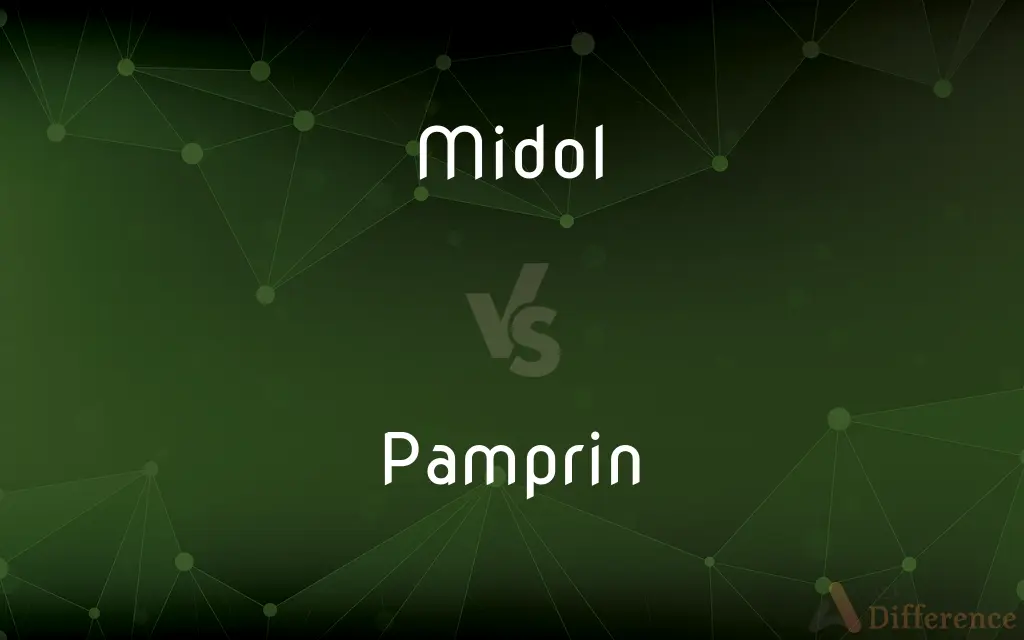Midol vs. Pamprin — What's the Difference?
Edited by Tayyaba Rehman — By Fiza Rafique — Published on December 7, 2023
"Midol" and "Pamprin" are both over-the-counter medications designed to relieve menstrual symptoms; while Midol addresses bloating, fatigue, and pain, Pamprin specifically targets pain, irritability, and emotional symptoms.

Difference Between Midol and Pamprin
Table of Contents
ADVERTISEMENT
Key Differences
"Midol" and "Pamprin" are popular over-the-counter brands that many individuals turn to for relief from menstrual discomfort. Both of these brands have been trusted by consumers for years and are often a go-to remedy for menstrual symptoms. While they share some similarities in purpose, they have different formulations and targeted symptoms.
"Midol" has been known to address a range of menstrual symptoms including bloating, fatigue, and pain. It often contains a pain reliever, like acetaminophen, as well as caffeine, which can help combat fatigue and alleviate water retention. For many, "Midol" is a comprehensive solution for those particularly challenging days of the menstrual cycle. Conversely, "Pamprin" focuses on alleviating menstrual pain and can also address irritability and other emotional symptoms that accompany menstruation.
One of the prominent distinctions between "Midol" and "Pamprin" is their ingredients. While both contain pain relievers, the specific type and the additional ingredients can vary. These variations often make one more suitable for certain symptoms than the other. For instance, if someone is particularly affected by mood swings or irritability during their period, they might lean more towards "Pamprin".
Furthermore, both "Midol" and "Pamprin" offer different product variations to cater to individual needs. For example, there are extended relief versions or versions without caffeine. It's essential to read the label and understand the ingredients and their functions when choosing between "Midol" and "Pamprin".
Ultimately, the choice between "Midol" and "Pamprin" boils down to personal preference and the specific symptoms one is looking to address. Both have proven effective for many, but what works best will vary from person to person. It's always advisable to consult with a healthcare professional when uncertain about which product to choose.
ADVERTISEMENT
Comparison Chart
Primary Use
Relieves menstrual symptoms
Relieves menstrual pain & emotional symptoms
Common Ingredients
Acetaminophen, caffeine
Acetaminophen, pyrilamine maleate, aspirin
Targeted Symptoms
Bloating, fatigue, pain
Pain, irritability, mood swings
Product Variations
Extended relief, caffeine-free, etc.
Multi-symptom, max strength, etc.
Popular Perception
Comprehensive menstrual relief
Emphasis on pain and emotional symptom relief
Compare with Definitions
Midol
"Midol" is a trusted brand for menstrual discomfort.
When her symptoms began, she immediately reached for Midol.
Pamprin
"Pamprin" is an over-the-counter medication for menstrual symptom relief.
Feeling irritable, she took a dose of Pamprin.
Midol
"Midol" is a brand of over-the-counter menstrual relief medication.
She took Midol to alleviate her cramps.
Pamprin
"Pamprin" contains ingredients like acetaminophen and pyrilamine maleate.
She read that Pamprin had pyrilamine maleate to address emotional symptoms.
Midol
"Midol" offers different product variations for specific needs.
She chose the extended relief Midol for longer-lasting comfort.
Pamprin
"Pamprin" can help alleviate menstrual pain and mood-related symptoms.
Her mood swings were intense, so she opted for Pamprin.
Midol
"Midol" often contains acetaminophen and caffeine.
Before purchasing, she checked if Midol contained caffeine.
Pamprin
"Pamprin" offers different product formulations for varied needs.
For her severe cramps, she chose Pamprin Max Strength.
Midol
"Midol" addresses symptoms like bloating, fatigue, and pain.
After feeling bloated, she decided to take Midol.
Pamprin
"Pamprin" is recognized for its focus on pain and emotional relief during menstruation.
With her irritability peaking, she knew Pamprin would help.
Common Curiosities
Can men take "Midol" or "Pamprin"?
Yes, while marketed for menstrual symptoms, the ingredients can relieve general pain or headaches.
What is "Midol"?
"Midol" is an over-the-counter medication used to treat menstrual symptoms.
Do both "Midol" and "Pamprin" contain the same ingredients?
No, while both may contain pain relievers, their specific ingredients and formulations differ.
And "Pamprin"?
"Pamprin" is also an over-the-counter medication, focusing on menstrual pain and emotional symptoms.
Are there side effects to taking "Midol" or "Pamprin"?
Yes, like all medications, they can have side effects. Always read the label and consult a healthcare professional if unsure.
"Midol" or "Pamprin"?
"Midol" is more commonly associated with relieving bloating.
Is caffeine present in both "Midol" and "Pamprin"?
Caffeine is commonly found in "Midol", but not all "Pamprin" formulations have it.
Why would someone choose "Pamprin" over "Midol"?
They might prefer "Pamprin" if they experience significant mood swings or irritability.
Can "Midol" and "Pamprin" be taken together?
It's crucial to consult a healthcare professional before combining any medications.
Share Your Discovery

Previous Comparison
Chemical Weathering vs. Mechanical Weathering
Next Comparison
Point Elasticity vs. Arc ElasticityAuthor Spotlight
Written by
Fiza RafiqueFiza Rafique is a skilled content writer at AskDifference.com, where she meticulously refines and enhances written pieces. Drawing from her vast editorial expertise, Fiza ensures clarity, accuracy, and precision in every article. Passionate about language, she continually seeks to elevate the quality of content for readers worldwide.
Edited by
Tayyaba RehmanTayyaba Rehman is a distinguished writer, currently serving as a primary contributor to askdifference.com. As a researcher in semantics and etymology, Tayyaba's passion for the complexity of languages and their distinctions has found a perfect home on the platform. Tayyaba delves into the intricacies of language, distinguishing between commonly confused words and phrases, thereby providing clarity for readers worldwide.












































